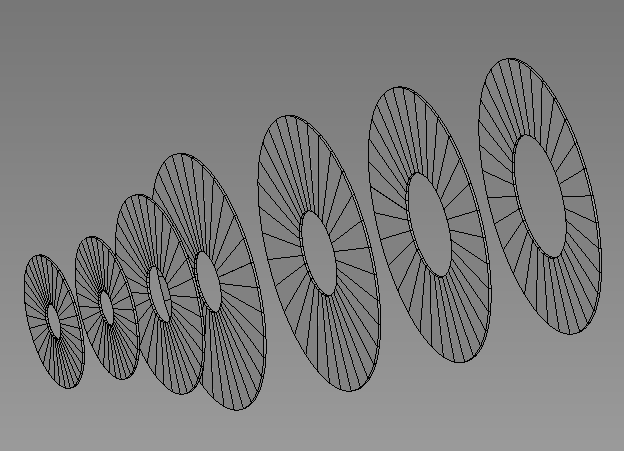|
 Discussion Discussion
In this document the requirements of a tracker for the very forward region of an ILC detector - covering the polar angle range between 6 and 20 degrees - have been discussed. The impact of the performance of design parameters like the space point resolution, the material budget and the integration has been evaluated. To this end several aspects of the performance - momentum resolution, pattern recognition - have been studied in detail using state-of-the-art simulation and reconstruction tools.
In this final section, the most important finding are summarized. The relative merits of the principal candidate detector technologies are discussed critically.
Challenges
Environment: While not as severe a constraint as in the vertex detector, the machine background certainly cannot be ignored. For nominal machine parameters the average hit density in the innermost disks is 2 × 10-4, locally reaching 10-3 at the smallest radii. The dependence on the parameters is quite strong: for low-power (high-luminosity) operation a factor 2 (4) increase in the average hit density is expected. The region of extremely high intensity - the "accumulation zone" - constrains the inner radius of the disks.
Momentum measurement: The goal of a momentum resolution of &Delta 1/ pT = 10-5 is a challenge for the barrel region. For the very forward region, where the orientation of the magnetic field is less favourable, the conservative setup considered in the section on momentum resolution remains a full order of magnitude below this limit. A more challenging detector can improve this figure, but the limit is likely to remain quite far.
Low momentum tracks: the abundance of the low-momentum tracks in the forward region presents a challenge to the pattern recognition capabilities of the FTD. The large effect of multiple scattering, in combination with the relative large distances (12 cm, 25 cm) between the different detector layers, leads to large uncertainties on the extrapolated position, and therefore a large probability to pick up unrelated hits, even if the track parameters are well constrained.
Vertexing: in the case of a "long barrel" vertex detector, the innermost measurement for particles at a very shallow polar angle is provided by the FTD. The extrapolation to the interaction point is rendered imprecise due to the large distance from the first (or even the second) disk. Vertexing and flavour tagging for very forward jets is therefore a real challenge.
Requirements
Material budget: the material budget has been confirmed as a critical parameter for nearly all aspects of the performance.
The multiple scattering term is found to dominate the momentum resolution up to momenta of 50 GeV. A significant improvement (a factor 2 with respect to the conservative estimate!) can be achieved if the first three layers of the detector can be built within a challenging material budget of 1.2 &permil/disk.
The material in the innermost disks is furthermore a decisive factor for the impact parameter resolution.
Also for pattern recognition the material budget is crucial. In the reconstruction of low momentum tracks - one of the great challenges of the forward region - the size of the search window on each disk is determined predominantly by the material. The compatible window in turn determines the level of ambiguity - the confusion - that the pattern recognition should resolve. In the study it was found that a standalone FTD based on macro-pixel technology with 1 &permil X0/disk can cleanly (fake rate less than 2 %) reconstruct tracks using only four disks. For a 1 % X0/disk forward tracker the fake rate reaches 5 %, and for a 10 % X0/disk it goes up to 23 %.
R-&phi resolution: The principal constraint for the R &phi resolution is given by the momentum resolution requirement. For tracks with large momentum (> 50 GeV in the forward tracker), the momentum resolution is proportional to the R &phi resolution. For the innermost disks, a better R &phi resolution helps to improve the vertexing and pattern recognition performance. Aim for 5 &mu m throughout the FTD.
R-resolution/cell size: This parameter has only marginal influence on the track parameter resolution. &footnote(The one exception is the longitudinal impact parameter estimate that is directly related to the resolution in this coordenate. However, even with the best resolution realistically achievable this parameter estimate remains inadequate for heavy flavour tagging.)
The constraints on this R-segmentation come from requirements on the pattern recognition performance. The maximum cell sizes have been determined in the section on standalone pattern recognition. The peak occupancy of 50 &mu m × 10 cm strip detectors on the first disks would reach 5 %. An FTD based on single-sided strip detectors - even in the outermost disks - is found to be inadequate for standalone pattern recognition.
At a given point, the pattern recognition performance does not improve signficantly for a further reduction of cell size. The performances of the setup with 10 &mu m and 100 &mu m precision in the first 3 disks is very similar. Similarly, there is little gain in reducing the R-resolution of the outermost disks to below 1 mm.
Integration time
The time stamping requirements in the FTD require at least the outermost two disks to be equipped with detectors that can identify a single bunch crossing.
The pressure from the hit density due to machine background requires fast read-out in the innermost disks. Provided the longer read-out time is accompanied by a reduction of the material (as in the case of active pixel technologies) stand-alone pattern recognition can be demonstrated to yield good results for integration times up to 10 bunch crossings. For much longer integration times the performance is inevitably degraded by the large density of background hits.
Home
|